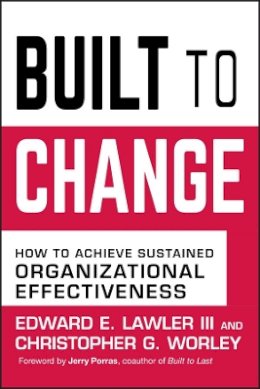21%OFF

Stock image for illustration purposes only - book cover, edition or condition may vary.
Built to Change: How to Achieve Sustained Organizational Effectiveness
III Edward E. Lawler
€ 32.99
€ 26.09
FREE Delivery in Ireland
Description for Built to Change: How to Achieve Sustained Organizational Effectiveness
Hardcover. Renowned management expert Ed Lawler and coauthor Chris Worley show how to create an organization that encourages experimentation, learning about new practices and technologies, monitoring the environment, assessing performance, and a commitment to continuously improving performance. Num Pages: 352 pages, illustrations. BIC Classification: KJM. Category: (P) Professional & Vocational. Dimension: 231 x 162 x 32. Weight in Grams: 676.
In this groundbreaking book, organizational effectiveness experts Edward Lawler and Christopher Worley show how organizations can be “built to change” so they can last and succeed in today’s global economy. Instead of striving to create a highly reliable Swiss watch that consistently produces the same behavior, they argue organizations need to be designed in ways that stimulate and facilitate change. Built to Change focuses on identifying practices and designs that organizations can adopt so that they are able to change. As Lawler and Worley point out, organizations that foster continuous change
In this groundbreaking book, organizational effectiveness experts Edward Lawler and Christopher Worley show how organizations can be “built to change” so they can last and succeed in today’s global economy. Instead of striving to create a highly reliable Swiss watch that consistently produces the same behavior, they argue organizations need to be designed in ways that stimulate and facilitate change. Built to Change focuses on identifying practices and designs that organizations can adopt so that they are able to change. As Lawler and Worley point out, organizations that foster continuous change
- Are closely connected to their environments
- Reward experimentation
- Learn about ... Read more
- Commit to continuously improving performance
- Seek temporary competitive advantages
Product Details
Format
Hardback
Publication date
2006
Publisher
John Wiley & Sons Inc United States
Number of pages
352
Condition
New
Number of Pages
352
Place of Publication
New York, United States
ISBN
9780787980610
SKU
V9780787980610
Shipping Time
Usually ships in 7 to 11 working days
Ref
99-50
About III Edward E. Lawler
THE AUTHORS Edward E. Lawler III is distinguished professor at the University of Southern California (USC) Marshall School of Business and founder and director of USC's Center for Effective Organizations. He is the author of Treat People Right! and a leading consultant to major corporations. Christopher G. Worley is a research scientist at USC's Center for ... Read more
Reviews for Built to Change: How to Achieve Sustained Organizational Effectiveness
Back in the good old days, when news travelled at the speed of telex and the world seemed big, change was something that happened to companies once every few years. Chief executives would initiate "change programmes" to rid their organisations of old habits and inculcate new ones. Strategy would be re-examined, priorities reset, jobs redesigned and reporting lines redrawn. ... Read more
